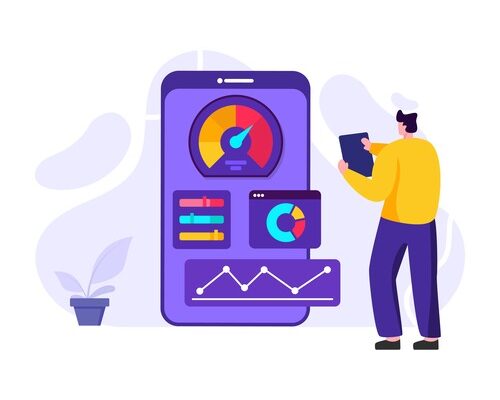Have you ever wondered what users do after downloading your iOS application? Do you know which features they use the most or whether your latest marketing campaign is actually delivering results?
Many businesses miss the valuable insights hidden within iOS application analytics. As a result, they operate with limited visibility into user behaviour, feature performance, and campaign effectiveness. Without this clarity, it becomes difficult to identify growth opportunities or improve the overall app experience.
Analytics help bridge this gap. By understanding how users interact with your application, you can make smarter decisions, refine features, and optimise your marketing efforts. Without analytics, businesses risk relying on assumptions instead of data.
At Mallow, we have helped numerous clients successfully launch iOS applications, and we consistently emphasise the importance of analytics in guiding an application’s growth. Over the years, we have developed strong expertise in analysing complex data, identifying user behaviour patterns, and converting insights into actionable strategies.
By the end of this article, you will gain a clear understanding of how to track user engagement and interpret analytics effectively. More importantly, you will learn how to use this data to make informed decisions that support continuous improvement and long-term business growth. This article will equip you with the knowledge needed to unlock the full potential of your iOS application through meaningful analytics.
Why do you need iOS app analytics?
Navigating iOS app analytics requires a clear understanding of the many metrics involved. These include user acquisition, retention rates, in-app navigation, and conversion funnels. Each metric adds context to how an application performs and how users interact with it.
When businesses make decisions based on analytics, they can improve user experience, refine marketing strategies, and adapt quickly to changing market needs. App analytics reveal how users engage with features and where improvements are needed. As noted by Branch.io, analytics help marketers and developers understand app performance, user behaviour, and areas that require optimisation.
Understanding user behaviour, engagement trends, and feature performance is no longer optional. In a competitive market, these insights are essential for making informed decisions. The data generated by users offers clear direction on what works and what does not.
By adopting a data-driven approach, businesses and developers can move beyond guesswork. This enables them to improve their applications continuously, respond to user needs effectively, and remain competitive in the evolving iOS app landscape.
What are some of the key metrics to track for analysing the growth of your business?
To make this easy to understand, we’re grouping the metrics to track into several different categories.
Acquisition and Retention Metrics

App downloads
App downloads are often the first indicator of an iOS application’s reach. Tracking download numbers helps you understand how visible your app is and how well your marketing efforts are working. This metric reflects user interest, app store optimisation effectiveness, and overall market awareness.
While downloads alone do not define success, they provide an essential starting point. They help you evaluate how appealing your app is within the competitive iOS ecosystem and whether your promotional strategies are generating attention.
Geolocation – Geolocation metrics show where users are accessing your app from. This information is useful for understanding regional usage patterns and audience distribution. Businesses can use this data to deliver location-specific content and personalised experiences. Geolocation data also supports more targeted marketing strategies. By analysing behaviour across regions, teams can tailor campaigns, messaging, and features to better suit local user preferences.
User retention rate
User retention measures how many users continue using the app after their first interaction. A strong retention rate indicates that users find long-term value in the app. A declining rate may highlight issues related to usability, content quality, or feature relevance. Tracking retention helps businesses identify engagement gaps and improve the overall experience.
Acquisition channels
Acquisition channels reveal how users discover and download your app. These channels may include organic search, paid advertising, social media, referrals, or partnerships. Understanding these sources helps businesses identify which channels deliver the most valuable users.
By analysing acquisition data, teams can invest more effectively in high-performing channels. This enables better budget allocation, stronger campaign performance, and improved user quality, ultimately supporting sustainable growth.
User engagement metrics

Daily Active Users (DAU)
Daily Active Users is a key metric for understanding the short-term and immediate impact of your iOS application. It shows the number of unique users who actively engage with your app each day, offering a real-time view of user activity.
Tracking DAU helps measure app popularity and uncover usage patterns. According to a 2025 report by Business of Apps, around 16% of active users open apps daily, with the news and magazines category leading at 32%. A rising DAU indicates growing engagement, while a decline may highlight issues related to user experience, feature relevance, or marketing effectiveness.
To gain deeper insights, session-related metrics can be customised based on your app’s goals. For example, you can track how long users stay active in a session or how frequently they use specific features.
Monthly Active Users (MAU)
Monthly Active Users provides a broader view of engagement by measuring how many unique users interact with your app over a month. This metric is useful for understanding long-term usage trends and overall app reach.
A stable or increasing MAU suggests strong user retention and ongoing relevance. Businesses focused on sustainable growth can use MAU to guide decisions around feature improvements, retention strategies, and user experience enhancements.
Session duration
Session duration measures how long users stay active in your app during a single session. It reflects how engaging and valuable users find the app experience.
Longer sessions often indicate higher user satisfaction and deeper interaction with features or content. Shorter sessions may point to usability challenges or a lack of compelling content. By analysing session duration, teams can identify what keeps users engaged and optimise the app to better match user expectations.
Understanding this metric enables developers and businesses to refine content, improve navigation, and enhance overall engagement, leading to a more satisfying user experience.
User behaviour- related metrics

Heatmaps
Understanding how users interact with your iOS application is essential for improving user experience and optimising key features. Heatmaps provide a visual representation of user interactions by highlighting areas of the app that receive the most engagement.
For example, heatmaps can show which buttons users tap most often or which sections of a screen attract the most attention. These insights help developers make informed design decisions, identify high-performing features, and uncover usability issues that may otherwise go unnoticed.
By analysing heatmap data, teams can refine layouts, reposition critical elements, and improve overall app usability based on real user behaviour.
Recordings and behaviour flow
Session recordings offer a detailed view of how users navigate and interact with your app in real time. As noted by UXCam, session recordings reveal user behaviours that traditional analytics may miss, making it easier to identify friction points and usability challenges.
By observing recorded sessions, developers can follow the complete user journey, from app launch to specific actions taken within the interface. This helps uncover recurring patterns, unexpected behaviours, and areas where users struggle.
When combined with behaviour flow analysis, which visualises the sequence of steps users take through the app, these tools provide a comprehensive understanding of the user experience. Behaviour flow also helps identify stages where users drop off, allowing teams to focus on improving specific screens or interactions that may be causing disengagement. Addressing these issues can significantly improve user retention and satisfaction.
Page visits metrics
Page visit metrics offer a clear, quantitative view of how users engage with different sections of your iOS application. By tracking which pages are visited most frequently and how much time users spend on each one, developers can better understand content relevance and user interest.
These insights support decisions related to content placement, feature visibility, and overall navigation structure. Whether refining the home screen or improving in-app flows, page visit data helps align the app experience with user expectations and preferences.
Custom application-related metrics

Custom application metrics offer a tailored view of your iOS app’s performance. Unlike standard metrics, these focus on insights that align directly with your business goals and user experience. Below are key types of custom metrics that can help you better understand and optimise your app.
- Conversion rates – Track how effectively users move through important actions in your app. Examples include measuring the percentage of users who register after downloading the app or complete a purchase after viewing a product. These metrics help identify friction points in key user journeys.
- Gender and age-related metrics – Collecting age group and gender distribution data helps you understand who your users are. This information supports targeted marketing, personalised content, and UI decisions that better match the preferences of specific demographic groups.
- Feature adoption – Measure how users interact with newly released features. Tracking how many users actively use a new feature helps determine whether it delivers value or requires refinement, better onboarding, or improved visibility.
- Custom events – Define and track actions that matter most to your app’s success. These may include button clicks, form submissions, content interactions, or any behaviour unique to your application. Custom events provide deeper visibility into how users engage with critical workflows.
- User segmentation – Group users based on criteria such as behaviour, location, usage patterns, or demographics. Segmentation allows for more precise analysis and enables personalised experiences, targeted messaging, and smarter product decisions.
- In-app purchases and revenue metrics – Monitor monetisation performance by tracking metrics such as average revenue per user (ARPU), customer lifetime value (CLV), and purchase conversion rates. These insights help evaluate pricing strategies, promotions, and long-term revenue potential.
- Custom engagement scores – Create an engagement score by combining multiple behaviours, such as session frequency, feature usage, and time spent in the app. This score helps identify highly engaged users and users who may benefit from re-engagement efforts.
- User feedback analysis – Analyse feedback from reviews, surveys, and in-app messages. Categorising feedback helps uncover recurring issues, feature requests, and positive signals, guiding product improvements and future updates.
Performance Metrics

Performance metrics are essential for delivering a smooth and reliable user experience. These metrics help you understand how efficiently your iOS application runs and where improvements are needed.
- Load times – Measure how long your app takes to launch and become usable. Break this down by screens, features, or components to identify slow areas. Metrics such as app launch time and screen rendering time directly affect user satisfaction.
- Network performance – Evaluate how quickly and reliably your app communicates with servers. Track API response times, latency, and network error rates to detect bottlenecks and improve data loading efficiency.
- Frame rate – Monitor how smoothly your app renders animations and transitions. A consistent frame rate improves visual quality and usability. Frames per second (FPS) metrics help identify performance issues that cause stuttering or lag.
- Battery consumption – Assess how much battery your app consumes during use. These metrics highlight background tasks or resource-heavy processes that may drain battery life and frustrate users.
- User response time – Track how quickly the app reacts to user actions such as taps, swipes, or navigation. Faster response times create a more fluid and intuitive experience.
- Application errors and crashes – Monitor error frequency and crash rates to understand stability issues. Metrics like crash frequency, crash-free users, and detailed crash logs help identify recurring problems and prioritise fixes.
- App size – Keep track of the app’s installation size. Larger apps can lead to longer download times, higher storage usage, and reduced willingness to install or update, especially for users with limited device space.
Device-related metrics

Collecting and analysing device-specific data is essential for understanding how users interact with your iOS application across different environments. This includes details such as device models, screen sizes, and iOS versions.
These metrics help you understand the range of devices your app supports and how well it performs across them. By analysing this data, you can optimise layouts for different screen resolutions, identify device-specific issues, and ensure compatibility with both newer and older iOS versions. This insight is especially valuable for prioritising testing efforts and delivering a consistent experience to all users.
The table below provides an overview of tools that can be effectively used to measure and analyse various iOS application metrics.
| Analytics Tool | Tracked Metrics |
| Google analytics for mobile | User Engagement (Sessions, Active Users)Crash ReportsUser Acquisition (Source, Medium, Campaign)Retention RateIn-App Events (Custom Events)Conversion TrackingEvent tracking for E-commerce and purchase eventsUser behaviour flow metrics Funnel Metrics |
| Firebase analytics | User Engagement (Active Users, Retention)Crash ReportingUser Behaviour (In-App Purchases, Conversions)Audience SegmentationConversion TrackingCustom Events and Parameters |
| Flurry analytics | User RetentionAd PerformanceSession FrequencyDemographics and User CharacteristicsEvents and Event SegmentationGeographic Distribution |
| Mixpanel | Funnel Analysis and metricsUser RetentionA/B TestingNotifications and Push AnalyticsRevenue TrackingUser Surveys and FeedbackUser behaviour flow metric |
| Amplitude | Behavioural AnalyticsUser SegmentationEvent TrackingRetention AnalysisConversion Funnel AnalysisRevenue Metrics |
| Countly | Session and User RetentionUser SegmentationFunnel AnalysisCrash ReportingPerformance Monitoring |
| Heap analytics | User Interactions and EventsFunnel AnalysisRetention and Conversion TrackingClick and Scroll HeatmapsA/B TestingSession replayHeatmapsUser journey |
| Smartlook | Session RecordingsHeatmapsEvent TrackingConversion FunnelsError TrackingRetention Analytics |
| Uxcam | Session RecordingsTouch HeatmapsUser AnalyticsConversion FunnelsIssue detection |
What would your journey from idea to app store look like?
At this point, you have a clear understanding of how iOS application analytics can help you make informed, data-driven decisions. You now know how to use these insights to evaluate performance, understand user behaviour, and guide business decisions effectively.
If your analytics indicate poor or declining results, it is important to take action. Metrics such as low engagement, high drop-off rates, or increased crash reports often point to issues like slow load times, app instability, or an inefficient user experience. These problems can discourage users and directly affect business outcomes.
Improving application performance becomes essential in such cases. Optimising speed, stability, and usability helps ensure a smooth experience for users and supports long-term growth and retention. For more details on how to optimise iOS application performance, do check out the article on how to optimise iOS application performance.
Still unsure about your next step? Feel free to reach out to our team.
Your queries, our answers
Mobile application development involves creating software applications designed to run on mobile devices like smartphones and tablets. These apps can be native (built specifically for iOS or Android), cross-platform (designed to work on multiple platforms), or hybrid (combining elements of both).
Our mobile app development process includes the following stages: requirement gathering and analysis, design and prototyping, development and coding, testing and quality assurance, deployment, and post-launch support. Each stage is crucial to delivering a high-quality application.
To gain deeper insights into the experience of working on a mobile project with Mallow, explore more details here.
The choice between native and cross-platform development depends on your project’s goals, budget, and target audience. Native apps offer better performance and a more tailored user experience, while cross-platform apps allow for faster development and lower costs by using a single codebase for multiple platforms. For a detailed comparison of Native vs. Hybrid development, explore our comprehensive analysis to help you make an informed choice.
Mallow develops mobile apps for iOS, Android, and cross-platform solutions. We use the latest technologies and frameworks to ensure your app performs optimally on the platforms that matter most to your users.
Choosing the right features for your mobile app depends on understanding your target audience, business goals, and budget. We work closely with you to prioritize features that will provide the most value to your users and align with your business objectives.
At Mallow, we offer ongoing app maintenance and updates as part of our post-launch services. This includes regular updates to improve performance, add new features, and ensure compatibility with the latest operating systems. For more details, get in touch with our team.
Yes, Mallow assists with the entire app store submission process, including meeting the guidelines for Apple’s App Store and Google Play. We ensure your app is ready for submission and provide support to help it get approved.
Mallow uses a variety of technologies and frameworks for mobile app development, including Swift and Objective-C for iOS, Kotlin and Java for Android, and React Native and Flutter for cross-platform development. Our technology choices are driven by the specific needs of your project.
Our testing process includes functional testing, performance testing, security testing, usability testing, and compatibility testing across different devices and operating systems. We ensure your app is bug-free and performs optimally before it goes live.
The cost of developing a mobile app depends on several factors, including the app’s complexity, features, platform (iOS, Android, or both), and the development team’s expertise. Costs can range from $10,000 to $150,000 or more. To know more, check out how much it costs to work on a mobile project with us.
The development timeline for a mobile app varies depending on the complexity of the project. A basic app may take 2-4 months to develop, while a more complex app with advanced features can take 6-12 months or longer.
Choosing the right features for your mobile app depends on understanding your target audience, business goals, and budget. We work closely with you to prioritize features that will provide the most value to your users and align with your business objectives.
Yes, Mallow offers comprehensive post-launch support, including monitoring, updates, bug fixes, and enhancements. We ensure your app remains up-to-date and continues to perform well after it’s launched.
A mobile app can enhance customer engagement, increase brand visibility, provide better service through personalized experiences, and create new revenue streams. It also allows you to reach a broader audience by making your services more accessible on mobile devices.
Getting started with Mallow is easy! Simply reach out to us to discuss your project. We’ll work with you to understand your goals, define your requirements, and create a development plan that meets your needs. Let’s bring your mobile app idea to life!.
Security is a top priority at Mallow. We implement advanced security measures, including encryption, secure authentication, and regular security audits, to protect your app from potential threats and ensure data integrity.
To learn more about how we handle and implement these security measures, check out more details here.
Author
Yogesh Murugesh
Yogesh is an accomplished Senior Technical Lead at Mallow, boasting over 11 years of invaluable expertise in the realm of application development. With an extensive background spanning diverse domains, he has consistently delivered applications of the highest calibre. Yogesh's commitment to quality and excellence shines through in every project he undertakes. His career journey is marked by a proven track record of successfully crafting applications that not only meet but often exceed industry standards. His ability to navigate through various domains showcases his adaptability and keen problem-solving skills. Yogesh's contributions have consistently played a pivotal role in driving technological innovation and advancement within his field. Beyond his professional pursuits, Yogesh finds solace and joy in various activities. An ardent cricket enthusiast, he embraces the team spirit and strategic thinking that the sport demands. During leisure moments, he indulges in watching movies, allowing himself to be captivated by different narratives and genres. Moreover, Yogesh cherishes quality time with his child, relishing the role of a devoted parent.



